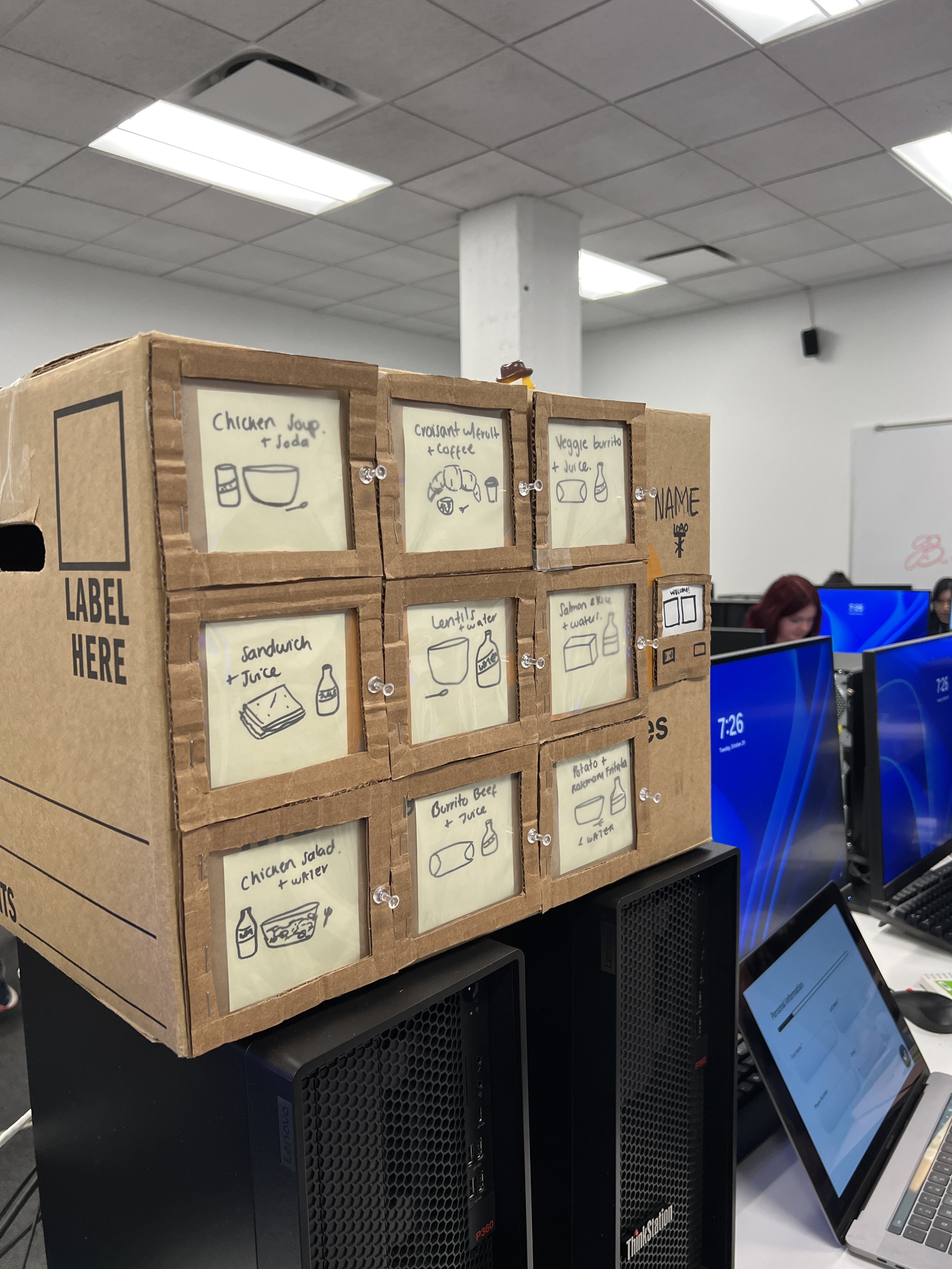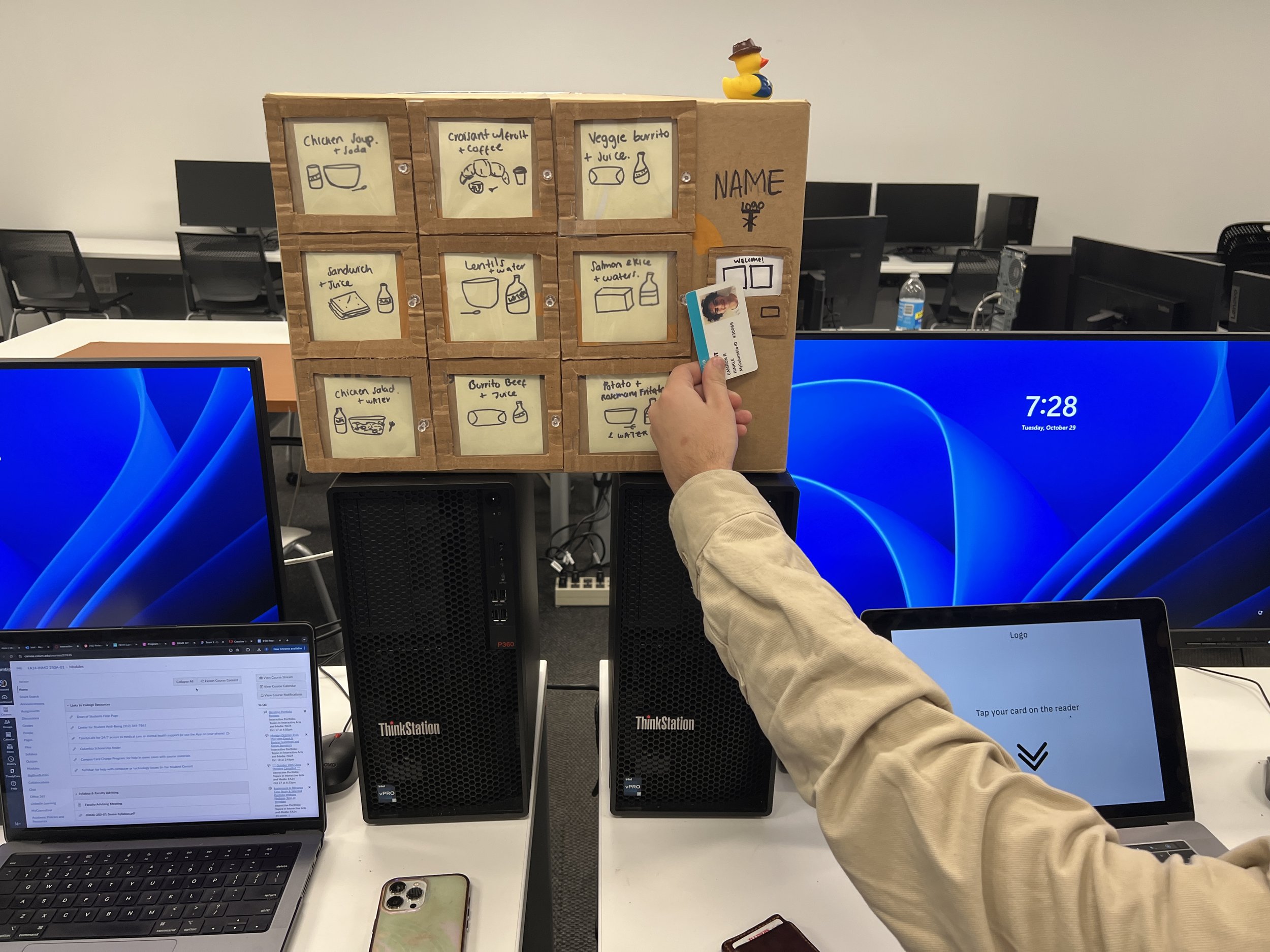Timeline
15 Weeks
Team
4 UX Designers 🎉
Role
Project Manager
UX Designer
Scope
White paper research, Competitive analysis, Qualitative survey, User interviews, Crazy 8’s, Mood board, Card sort, Style guide, Visual Design.
problem
Food-insecure individuals, who may struggle with limited access to technology or feel uneasy visiting food pantries and donation centers, need a solution that provides support in a way that is both accessible, available 24/7, and free from social stigma.
solution
No human contact food redistribution kiosk that is very quick to use.
Establishing partnerships with sports arenas and restaurants enables efficient food redistribution, made accessible through a simple touch of a kiosk.
Kiosk service is accessible with a card that users would register for with the touch of the kiosk.
White paper research
Food rescue has huge potential, yet food is wasted while millions go hungry.
40% of food is wasted, which is enough to feed those who are facing food insecurity.
The U.S. Department of Agriculture estimates that up to 40% of food is lost post-harvest, totaling approximately 133 billion pounds. This wasted food could feed the 258 million people experiencing severe food insecurity, a number that reached crisis levels in 2022, according to the Integrated Food Security Phase Classification (USDA).
competitive analysis
The competitors shared goal was the distribution of food from providers to food-insecure individuals.
The Strength
Clients are ensured they will be listened to and cared for during this time. Proper funding and participation allows each competitors service was allocated for all possible situations the demographic might face.
The Weakness
All competitors use digital services to house their information - which is not a common option for a majority of their demographic.
Additionally, users might not even know about these resources just because of lack of exposure.
qualitative survey
Surveys revealed that individuals in commercial and food-secure sectors are interested in learning how they can reduce food waste and contribute to food donation efforts.
USER INTERVIEWS
Interviews highlighted that food insecurity exists on a spectrum, with varying levels of need. Individuals with stable housing who experience food insecurity often avoid food pantries or donation facilities due to perceived social stigma.
Major Insights
Recognizing that Food Insecurity is a Spectrum of Needs and Experiences
Food-insecure individuals using EBT/SNAP may feel uncomfortable or unwelcome at food pantries or donation centers.
Ensuring Access to Culturally and Dietarily Appropriate Food for the Food-Insecure
Food-insecure individuals should have access to food that accommodates their cultural, dietary, and allergen-specific needs.
Addressing Barriers for Food-Insecure Individuals Without Access to Technology
Food-insecure individuals without access to technology face barriers in finding and accessing resources.
THE GAP
To bridge the gap between food waste and hunger, we need a solution that tackles both surplus food and the challenges faced by food-insecure people. Many using EBT/SNAP feel unwelcome at food pantries, and there’s limited access to food that meets cultural or dietary needs. People without technology also struggle to find resources.
crazy 8’s
We explored various solutions addressing the challenges of food waste and redistribution.
expert INTERVIEW
After ideating solutions, we realized food waste is a multifaceted issue, and we wanted to solve everything. As a team, we decided to consult with an expert in food rescue.
In our interview with Chicago Food Rescue CEO, Jake Tepperman he said “We need to work collaboratively with other food recovery and food insecurity organizations, as well as other local organizations in Chicago to really solve the issue. So I just want to dispel the notion that this isn't the best solution. It is simply part of a larger solution. But, yeah, what I do think is really important about it is figuring out how to fill the gaps where they already exist.”
mood board
The food redistribution kiosk in my Crazy 8’s was selected as a team after the interview with Jake, We then started moodboarding to visualize how the service would look and feel for users.
LOW FIDELITY
Physical prototype
We developed a mini prototype of the kiosk locker to bring the experience to life.
feedback based on user testing
The welcome screen and logged-in screen were too similar, causing confusion after users scanned their cards.
Since allergies can vary from common to rare, we needed a simplified way for users to add their allergies on a single screen. Users weren’t aware they could type their allergies in, so it needed to be more intuitive.
The stepper was unclear to users, appearing as just a black bar without enough context.
Adding an information icon at each step of the onboarding process to clarify the purpose of the questions and how they benefit the user.
cardsort
To define the key qualities of our service, we conducted a card sorting exercise.
logo iterations
Our aim was to stand out from other food redistribution services while highlighting a focus on innovation.
Through interviews we learned that the term 'White Box' originates as slang among unhoused, food-insecure individuals for leftover food. Our goal was to communicate a sense of warmth and innovation. We explored abstract shapes and box silhouettes during the design process.
Final logo
We chose an abstract approach for our logo to emphasize innovation and experimentation.
An abstract illustration representing this quote features a square with 40% of it cut out in the shape of a circle. This design visually symbolizes the staggering fact that the U.S. Department of Agriculture estimates over 40% of food is lost post-harvest—roughly 133 billion pounds. This wasted food could feed the 258 million people facing severe food insecurity in 2022, as reported by the Integrated Food Security Phase Classification.


































